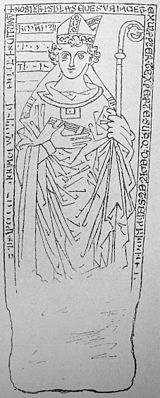Hermann II von Katzenelnbogen

Hermann II von Katzenelnbogen (* 1130 or 1140; † June 9, 1203 ) was the 24th Bishop of Münster from 1174 to 1203 and is named the first Prince-Bishop of Münster. He comes from the noble family of the Counts of Katzenelnbogen . He is buried in the choir of the Marienfeld Monastery , the cornerstone of which he laid himself.
Life
When Hermann II was canon of the cathedral in Würzburg, the Münster bishop Ludwig I von Wippra died on December 26th, 1173. Emperor Friedrich I Barbarossa appointed Hermann II as the bishop's successor.
crusade
In preparation for the Third Crusade , Emperor Friedrich I Barbarossa sent an embassy under the leadership of Hermann II to Emperor Isaac II Angelus in Constantinople . From 1189 to 1192 Hermann II took part in the crusade himself and was part of the emperor's inner circle. The nobleman Widukind von Rheda , also one of the founders of Marienfeld, also took part in this crusade and fell during the storming of Acre . It cannot be ruled out that it was Bishop Hermann II who had the noble lord's remains brought back to Germany. In the wake of the bishop, his other vassals also took part in the Third Crusade.
Death and burial
Hermann II probably gave up his various offices and activities in Münster before the turn of the century and retired to Marienfeld. In 1203 he died as a simple monk and was buried in Marienfeld. It was a grand gesture for the Convention. Therefore, he was buried in the choir room with his eyes turned to the high altar. A tomb was added later, which is no longer in its original location.
His grave inscription reads:
Nobilis hic praesul de sede sua iacet exul
propter te, Christe, pro te sua qui dedit et se.
Hic primum templi lapidem iacens iacet isti
subiectus lapidi, templi lapis ipse superni
Vivus et electus sit sacris sedibus aptungat
et sibi lapis utraque qui facit unum.
Obiit in the Medardi episcopi
Translation:
Here lies a noble bishop far from his [episcopal] seat,
who for your sake, Christ, gave his [= his possessions] for you and laying
the first stone of the temple here, he lies under this
stone, he is himself a living and chosen stone of that higher [= heavenly] temple,
worthy of the holy seats and unite with that stone,
which unites both stones [= Christ].
He died on the feast of Bishop Medardus.
Services
Hermann II was the first to have the right to mint and so coins for the entire diocese were struck under him in Münster since 1180.
On November 1, 1185, Hermann II laid the foundation stone of the Cistercian monastery in Marienfeld. On the way there, the bishop celebrated a holy mass in Freckenhorst . 1600 marks were sacrificed to him for the new monastery. In addition to this money, he also donated the church of the parish Wadenhart, the tithe to Erthborch, the tithe of an inheritance to Meppedeslo, to Rehe and to Gropenloh and in 1186 the Margarethenkapelle to Isselhorst . In order for Marienfeld to be accepted into the order, Hermann II had turned to the General Chapter of the Cistercian Order. He endowed Marienfeld with rights that secured the existence of the monastery until it was abolished in 1803. This monastery was under the special protection of Hermann II and marked the borders of the dioceses of Münster, Osnabrück and Paderborn .
Hermann II took part in the consecration of the monastery church of the Cistercian monastery Eberbach in 1186 . The Counts of Katzenelnbogen contributed a lot to the development of this monastery.
Around 1200 Hermann II gave Coesfeld and Warendorf city rights.
Works
Some cities were founded by Bishop Hermann II ( e.g. Coesfeld , Nienborg , Warendorf , Beckum , Ahlen and Dülmen ). At his bishopric in Münster he founded the parishes of St. Ludgeri , St. Martini , St. Aegidii and St. Servatii and in preparation for the founding of the city of St. Jakobi in Coesfeld. The parish division in Münster and the construction of the fortification walls there go back to him. He had the western transept added to the cathedral.
Representations of the bishop
In addition to the depiction on his grave slab in the Marienfeld monastery church, the lower third of which has been removed, there is a double painting by Mosler in the former town hall festival hall in Münster. It shows Prince-Bishop Hermann II on the left and Johann Niesing on the right.
See also
literature
- Andreas Sassen, Ernstjosef Weber: Contributions to local history - the grave slabs of the donors in the Marienfeld monastery church . 2005
- Hugo Stehkämper : Hermann II of Katzenelnbogen. In: New German Biography (NDB). Volume 8, Duncker & Humblot, Berlin 1969, ISBN 3-428-00189-3 , p. 638 ( digitized version ).
- Walter Werland: Marienfelder Chronik. On the history of the Cistercian abbey and the Marienfeld community . (available at the Citizens' Office of the City of Harsewinkel)
Web links
Individual evidence
- ↑ Gabriele Böhm: Medieval figural tombs in Westphalia from the beginnings to 1400, LIT Verlag Münster, pp. 73-77
- ^ Walter Werland, Marienfelder Chronik, p. 57.
| predecessor | Office | successor |
|---|---|---|
| Ludwig I of Wippra |
Bishop of Münster 1174–1203 |
Otto I of Oldenburg |
| personal data | |
|---|---|
| SURNAME | Hermann II von Katzenelnbogen |
| BRIEF DESCRIPTION | German Roman Catholic clergyman; Bishop of Münster (1174–1203) |
| DATE OF BIRTH | 1130 or 1140 |
| DATE OF DEATH | June 9, 1203 |
